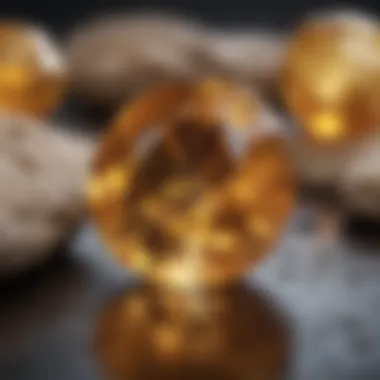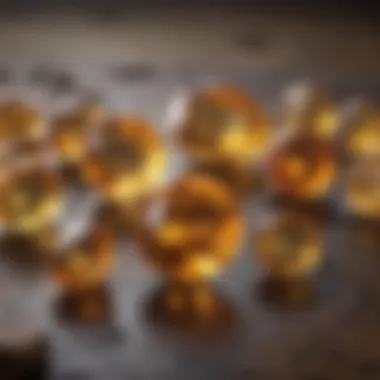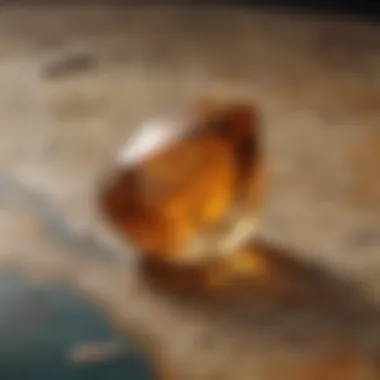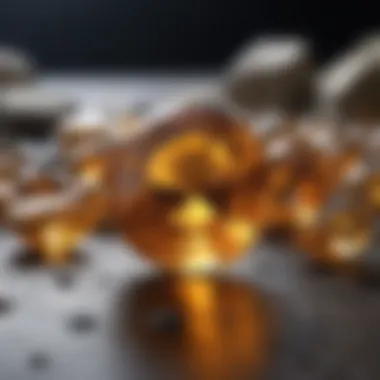Understanding Citrine Cost: A Comprehensive Guide


Intro
Citrine is a variant of quartz that captivates collectors and enthusiasts alike. The golden-yellow hue provides an appealing aesthetic, making it a sought-after gemstone. Understanding the financial aspects of citrine, from its various attributes to price trends, is essential for collectors. In this guide, we will explore key factors influencing citrine's cost and provide insights to assist in informed purchasing decisions.
History and Origins
Citrine's appeal is not merely contemporary; its history is rich and varied. The gemstone has been valued since ancient times, often associated with wealth and prosperity.
Overview of Collectibles, Rocks, and Fossils
Citrine, like many gemstones, fits into a broader category of collectible items. Collectors often look for unique pieces that hold both aesthetic and financial value. Understanding the origins of citrine can enhance appreciation for this stone. It primarily forms in granitic rocks, making its availability limited compared to other quartz types.
Historical Significance and Cultural Impact
Throughout history, citrine has been used in jewelry and art. In ancient Greece, it was worn as a protective stone. Many cultures ascribed healing properties to citrine, believing it could bring wealth and happiness. Today, citrine continues to maintain cultural significance as a stone of abundance.
Identification and Classification
Recognizing quality citrine is crucial for collectors. Misidentification can lead to overpaying for inferior stones.
Guide to Identifying Citrine
To identify genuine citrine, observe the following:
- Color: Authentic citrine displays a vibrant yellow to golden-brown color.
- Clarity: High-quality citrine should be clear with minimal inclusions.
- Cut: The way a gemstone is cut can affect its brilliance and overall appeal.
Common Types and Variations
Citrine can be found in various forms, each affecting its market value. Some popular variants include:
- Natural Citrine: This occurs organically in the earth.
- Heat-Treated Amethyst: Often transformed to resemble citrine, these stones can mislead inexperienced collectors.
- Synthetic Citrine: Man-made and generally less expensive, synthetic stones do not hold the same value as natural ones.
"Understanding the distinction between natural, heat-treated, and synthetic citrine is essential for making informed purchases."
Awareness of these variations allows collectors to make prudent choices when buying or trading citrine gemstones.
Preface to Citrine Pricing
Understanding the pricing of citrine is crucial for anyone interested in this exquisite gemstone. Citrine, a warm golden hue variant of quartz, is desired not only for its beauty but also for its investment potential. The market for citrine has evolved, and recognizing its cost factors can empower collectors and investors alike. This section provides a foundation for understanding what dictates the price of citrine, making it easier for buyers to navigate the complexities of the market.
Defining Citrine
Citrine is a type of quartz that is characterized by its yellow to golden brown color, caused by trace amounts of iron within the crystal structure. Its name is derived from the French word "citron," meaning lemon, reflecting its bright, cheerful hue. Citrine is the birthstone for November and is often associated with abundance and wealth. While its aesthetic appeal attracts many collectors, its market value can vary significantly based on different factors, including clarity, cut, and carat weight.
Historical Background of Citrine Value
The history of citrine and its value can be traced back to ancient civilizations. For centuries, this gem has been prized for its beauty and perceived healing properties. Ancient Greeks used citrine in their jewelry, and Egyptians are known to have utilized it as a protective amulet. Over time, citrine's popularity fluctuated, but its remarkable colors and availability have ensured it remains a favored choice among gem enthusiasts. In the modern market, the introduction and acceptance of various citrine types, including natural and treated varieties, have further influenced its valuation. This historical perspective allows collectors to appreciate citrine not just as an aesthetic choice but as a gem with a rich legacy.
Factors Influencing Citrine Cost
The cost of citrine is not determined by a single factor. Rather, it is shaped by a combination of various elements that come together to define its market value. Understanding these factors is crucial for any collector or investor interested in purchasing or trading citrine. Each element, from quality to market trends, adds layers to the pricing structure. This section will outline the primary factors influencing citrine cost, providing valuable insights for astute buyers and sellers alike.
Quality Assessment
The quality of citrine plays a vital role in its valuation. Multiple aspects fall under the umbrella of quality, including color, clarity, cut, and carat weight.


- Color: Citrine is most valuable when it exhibits a deep, rich golden hue. Paler stones may be less expensive.
- Clarity: Stones with fewer inclusions or blemishes typically command higher prices.
- Cut: The shape and angles contribute not only to aesthetics but also to how well the stone reflects light.
- Carat Weight: Larger stones are rarer and thus more sought after, affecting price significantly.
Understanding how these characteristics interplay can help buyers make informed decisions, identifying high-quality stones worth the investment.
Size and Weight Considerations
Size and weight factor prominently into citrine's market cost.
The carat weight directly influences the overall price. Larger stones are often more expensive. However, the relationship between size and value is not linear. A smaller, high-quality citrine may fetch a higher price than a larger one of inferior quality.
When considering a purchase, it is wise to assess the stone's total weight in conjunction with its quality. This comprehensive evaluation leads to better valuation insights.
Origin of Citrine
The source of citrine can significantly impact its price. Citrine primarily comes from countries like Brazil, Madagascar, and the United States.
- Brazilian Citrine: Known for its vibrant color and clarity, this tends to fetch higher prices.
- Madagascar Citrine: Often shows unique color variations and is gaining popularity among collectors.
- American Citrine: Generally more available but can vary widely in quality.
Each origin has its own characteristics and associated costs. Understanding these regional differences aids buyers in identifying value.
Market Demand and Trends
Market demand has a direct effect on pricing. The gemstone market fluctuates based on various trends.
When demand escalates, prices can soar. Trends may involve seasonal changes, shifting consumer preferences, or even celebrity endorsements. Paying attention to these trends can provide insights into when to buy or sell.
In particular, the rising popularity of citrine in jewelry and fashion often leads to increased interest and competitive pricing among sellers.
"Following market trends can provide strategic advantages for collectors seeking to maximize financial returns." By staying informed on current trends, buyers can navigate the market more effectively.
Citrine Market Categories
Understanding the market categories of citrine is crucial for both collectors and investors. Different aspects of citrine impact how it is valued and sold in the marketplace. Being aware of these categories enables buyers to make informed decisions. The distinction between natural citrine and treated or lab-created versions can significantly influence pricing and desirability.
Natural vs. Treated Citrine
Natural citrine refers to the gemstones that form naturally in the earth. Their hues can vary from pale yellow to deep amber. The lack of artificial treatment often results in higher value among collectors. Buyers generally prefer natural stones as they represent authenticity and natural beauty.
In contrast, treated citrine involves stones that undergo processes to enhance their color or clarity. This might include heat treatment or the use of radiation. While these methods can improve the visual appeal, they often decrease the stone's overall value. Collectors who focus on purity and rarity tend to shy away from treated stones. Knowing if a citrine is natural or treated can guide buyers in understanding its worth and resale potential.
Natural citrine maintains higher value due to its authenticity, while treated versions can lead to lower market prices.
Sourced vs. Lab-Created Citrine
Sourced citrine comes directly from the earth, extracted through mining operations. This category may include stones from well-known regions like Brazil or Madagascar. These mines produce stones that vary in quality and characteristics, impacting their market value.
On the other hand, lab-created citrine stones are produced in controlled environments. These stones often exhibit properties similar to natural citrine but are not considered 'authentic' by many collectors. While lab-created stones are generally more affordable, they do not hold the same investment potential as their natural counterparts.
In summary, understanding these two different categories—sourced and lab-created—helps buyers navigate the market effectively. Whether investing or collecting, knowing the source of citrine can shape future financial outcomes.
Valuation Techniques for Citrine
Valuation techniques for citrine are crucial for understanding the fair price of this gemstone. These techniques provide a framework for both buyers and sellers to gauge citrine's worth accurately. By utilizing structured assessment methods, individuals can prevent overpayment or undervaluation in transactions.
Professional Appraisal Methods
Professional appraisal methods are essential for accurate citrine valuation. Appraisers possess specialized knowledge and skills that provide insight into a gemstone's quality and market value. They evaluate various criteria, such as clarity, color, size, and cut, often using established grading systems.
Typically, an appraisal will begin with a visual inspection of the citrine gemstone. This is followed by the use of tools like loupes and microscopes to examine its characteristics more closely. Appraisers also consider the gemstone's overall aesthetic appeal, which can significantly influence price.
An important note is that appraisers maintain current knowledge about market trends. This is vital because the value of citrine can fluctuate based on demand and supply conditions. A professional appraisal can involve a fee, yet it offers peace of mind and often leads to better-informed decisions during buying or selling.
DIY Valuation Techniques
For those who prefer a more hands-on approach, DIY valuation techniques for citrine can provide a practical alternative. While these methods may not be as precise as professional appraisals, they enable collectors to gain a better understanding of their gemstone's value.
Here are some steps to consider when valuing citrine on your own:


- Research Market Prices: Start by browsing online marketplaces, like GemRockAuctions.com or Etsy, to gauge current market prices for similar citrine stones. This can help you understand the general pricing landscape.
- Check Gemstone Grading Systems: Familiarize yourself with the Gemological Institute of America's (GIA) grading system. Understanding how aspects like color, clarity, and cut affect value can empower you in your valuation process.
- Assess Quality: Evaluate your citrine gemstone under good lighting. Note its clarity and any inclusions present. The color should also be examined, ideally being a rich, warm yellow, as this impacts desirability.
- Record Size and Shape: Measure the size and note the shape of the gemstone. Larger citrine stones tend to have higher value.
Effective DIY techniques can furnish you with foundational knowledge and confidence when discussing or negotiating prices.
Although these DIY methods may not equate to a professional appraisal, they serve as a helpful guide. Understanding these valuation techniques fosters better decision-making and enhances the overall experience of citrine collectors.
Comparative Analysis of Citrine Prices
Analyzing citrine prices across various attributes is essential for collectors and investors alike. This understanding helps in making informed decisions when purchasing or trading this valuable gemstone. By exploring where citrine stands in different markets and regions, one can gain insights that can significantly affect their buying strategies.
Citrine Prices Across Different Markets
Citrine can be found in various markets, ranging from local gem shops to online platforms. Each market presents unique pricing dynamics influenced by factors like availability, buyer demographics, and regional demand. In brick-and-mortar stores, prices might carry a premium due to overhead costs. Online marketplaces like Etsy or eBay often showcase competitive pricing, driven by sellers from diverse backgrounds offering various qualities of stones.
When comparing markets, it's crucial to consider the market trend indicated by consumer interest. For example, if certain styles or cuts become fashionable, prices may surge. Similarly, auctions and specialized gemstone shows frequently witness higher bids due to emotional value associated with rare specimens. Thus, understanding where to buy relates not only to price but also to market sentiment.
Price Variations by Region
The geographical origin of citrine significantly influences its pricing. Various regions are known for producing distinct qualities of citrine. For instance, citrine sourced from Brazil is often prized for its rich color. In contrast, stones from the Congo may exhibit a paler hue, affecting their desirability and cost.
Moreover, local economic conditions can create price discrepancies. In countries where citrine is mined, such as Brazil or Madagascar, prices may be lower due to reduced transportation costs. Meanwhile, in regions far from the source of supply, prices tend to increase due to import fees, shipping, and retailer markups.
"The price of citrine has a strong correlation with its origin and market positioning."
In summary, when considering citrine prices, it is vital to analyze multiple factors. Understanding price variations across markets and regions offers a nuanced perspective. Collectors can leverage this knowledge to find value and make strategic purchasing decisions. Such analysis ultimately empowers buyers to engage thoughtfully with their investments in citrine gemstones.
Citrine Pricing in Collecting vs. Investment
Citrine, with its vibrant golden colors, is a gemstone that attracts both collectors and investors. Understanding the difference in pricing philosophies between these two groups is crucial for anyone in the citrine market. Collectors often seek specimens for their beauty and uniqueness, while investors typically focus on the potential for monetary gain. This distinction shapes the pricing landscape for citrine significantly.
Collector Trends and Pricing Strategies
Collectors often prioritize aesthetic appeal and unique characteristics of citrine. They are usually looking for stones that have an exceptional color saturation, clarity, and size. Prices in this segment often reflect individual preference and emotional value. Factors like the stone's origin can influence collector pricing significantly.
For instance, natural citrine from Brazil may command a higher price due to its perceived purity and quality compared to treated materials. Collectors may engage in buying citrine at gem shows, online auctions, or from specialty stores. It is common for them to establish long-lasting relationships with sellers, ensuring they get access to rare finds and potentially favorable pricing. Collectors may also invest in high-quality documentation or certifications from gemologists to optimize the value of their collection.
In terms of pricing strategies, savvy collectors may choose to buy during seasonal sales, ensuring that they can secure valuable pieces at lower rates. Auctions also offer opportunities for collectors to acquire unique specimens, sometimes below market value, if they are well-researched and patient.
Investment Perspectives
When it comes to investments, citrine often appeals to those looking for a solid and stable asset. Investors tend to analyze market trends and focus on potential future appreciation. Factors influencing citrine investments include scarcity, overall gemstone market conditions, and economic stability. Investors generally look for high-quality citrine, as this is where value appreciation is more likely.
As markets change, so do the perspectives on investment strategies for citrine. While some investors might engage in buying and selling actively within fluctuating markets, others adopt a long-term hold strategy. The latter aims for sustained growth, believing that citrine will appreciate over time as the global demand rises.
"The key to citrine investment is not only recognizing market trends but also understanding the unique characteristics that contribute to value."
Citrine, though not as sought-after as diamonds or sapphires for investment purposes, can generate profits under the right circumstances. Factors such as global economic conditions, the popularity of alternative gemstones, and the ecological implications of gemstone mining can significantly affect citrine’s investment potential. Investors often keep an eye on these dynamics, making informed decisions based on comprehensive market research.
In summary, while both collectors and investors may be interested in citrine, their motivations and strategies differ significantly. Understanding these aspects can help both groups navigate the market efficiently and achieve their goals.
Future Outlook for Citrine Prices
The future of citrine prices is an essential topic for collectors and investors alike. Understanding what may influence the value of citrine in coming years allows individuals to make informed decisions. As buyers engage in the market, they benefit from awareness of potential trends, challenges, and opportunities within the citrine sphere. Knowledge of these dynamics not only assists in purchasing but also aids in investment strategies.
Emerging Trends in the Citrine Market


A variety of trends are emerging in the citrine market, reshaping how collectors and investors approach transactions. One significant trend is the growing popularity of ethically sourced gemstones. As consumers become more environmentally and socially conscious, their demand for traceable and conflict-free stones increases. This shift could ultimately elevate the prices of ethically sourced citrine.
Another noteworthy development is the rise of online sales platforms. E-commerce provides broader accessibility to citrine gemstones, allowing for easier comparison across various sellers. The increased competition can drive prices down initially, but over time, less reputable sellers may disappear, leading to a stabilization of quality and pricing.
Finally, there's a noticeable increase in education surrounding gemstone valuation. As collectors learn more about quality indicators such as clarity, color, and cut, they are making more educated purchases. This heightened awareness can influence demand and, in turn, affect prices positively.
Potential Factors Affecting Future Costs
Several factors could influence the future costs of citrine, playing a pivotal role in its economic landscape. First, supply chain dynamics are critical. With mining operations subject to environmental regulations, sourcing could become more challenging, potentially increasing prices. The availability of natural citrine might tighten, shifting interest towards treated or synthetic alternatives.
Market demand is another key factor. As citrine's popularity rises, particularly among younger generations interested in healing properties and unique aesthetics, prices may trend upwards. Similarly, broader economic conditions can impact discretionary spending.
Moreover, geopolitical events can have a sudden impact on mineral extraction and transportation. Tariffs, trade restrictions, or unrest in producing regions can alter costs significantly. Collectors should consider these scenarios when evaluating potential investments.
"Understanding citrine's future trends and influencing factors can help in making informed purchasing or investment decisions."
In summary, staying updated on emerging trends and potential influencing factors is crucial. By following these aspects, collectors and investors can navigate the complexities of the citrine market. Effective decision-making relies on comprehending these ongoing changes.
Practical Tips for Buyers
When navigating the realm of citrine purchasing, prospective buyers encounter a myriad of options and considerations. Understanding the subtleties of these choices can significantly influence one's satisfaction with the investment. This section serves as a practical guide for anyone involved in the trading or collecting of citrine, emphasizing essential strategies and insights aimed at enhancing the purchasing experience.
Where to Buy Citrine
Identifying the right sources for purchasing citrine is crucial. Various markets exist, ranging from local gem fairs to online retailing. Here are the most notable options:
- Local Gem Shows: Attending gem and mineral shows can expose collectors to high-quality specimens directly from vendors. Suppliers often have local stones that are unique or less commonly found online.
- Specialized Retailers: Stores that focus on gemstones or metaphysical products can provide a curated selection of citrine. These retailers often have knowledgeable staff who can offer valuable insights regarding quality.
- Online Marketplaces: Websites such as eBay or Etsy have a wide range of citrine options. However, it is essential to review seller ratings and feedback carefully as these platforms may have both reputable and less trustworthy vendors.
- Auction Houses: For collectors seeking rare citrine pieces, established auction houses may be an excellent choice. They often feature high-quality gemstones and provide authenticity assurances before bidding.
Each of these avenues presents a different purchasing experience, with varying degrees of reliability, so consider the context of each purchase carefully.
Evaluating Quality Before Purchase
Quality assessment is pivotal when buying citrine. A well-informed buyer not only recognizes the impact of quality on price but also appreciates the factors that define it. Here are some guiding points:
- Color: Look for a vibrant yellow or golden hue. The more saturated and uniform the color, the higher the potential value.
- Clarity: Ideally, citrine should be free from visible inclusions. While some impurities may be acceptable, avoiding those that detract from the visual appeal is advisable.
- Cut: The quality of the cut significantly influences the stone's brilliance. Ensure the stone is cut symmetrically and effectively showcases its natural light-reflecting properties.
- Carat Weight: Larger stones tend to fetch higher prices, but the price per carat may decrease as the size increases. Consider what size fits your needs and budget.
Buyers should also request a certificate of authenticity if available. This document can provide assurance about the stone's origin and treatment, especially from reputable sources.
"Investing time in understanding the criteria for citrine quality is likely to pay off in achieving a satisfying purchase."
Ending
The conclusion serves as a pivotal element in any comprehensive guide, especially when discussing the multifaceted aspects of citrine cost. It provides readers with a synthesized understanding of the key points covered throughout the article. In this case, it reinforces the varied factors influencing citrine pricing, from quality and size to origin and market dynamics.
Summarizing the key insights helps readers consolidate their knowledge, ensuring they leave with a clear grasp of the topic. The emphasis on professional appraisal methods and DIY valuation techniques is crucial for both new and experienced collectors, equipping them with practical tools to assess citrine effectively. This understanding is not just theoretical but has actionable benefits in real-world scenarios, such as purchasing decisions or determining investment potential.
Additionally, the conclusion addresses the ever-evolving nature of the citrine market and its implications for pricing. Collectors and investors must stay vigilant about emerging trends, market demands, and potential influencing factors. A thorough grasp of these aspects can significantly impact one’s buying strategies and investment choices. Ultimately, this section synthesizes all critical elements of citrine valuation, leaving readers well-informed and prepared for future endeavors in their citrine transactions.
Summarizing Key Points on Citrine Cost
Understanding the cost of citrine involves recognizing several essential factors:
- Quality Assessment: Higher quality citrine exhibits more vibrant colors and fewer inclusions.
- Size and Weight: Larger stones command higher prices, as they are rarer in nature.
- Origin: Citrine from renowned sources, such as Brazil or Madagascar, is often valued more due to perceived quality.
- Market Demand: Popularity trends and seasonal fluctuations can impact citrine's price.
Recognizing these elements allows buyers to approach the market with informed expectations.
Final Thoughts for Collectors and Investors
For collectors and investors, the judicious evaluation of citrine is paramount. Consider the following points:
- Do Your Research: Familiarize yourself with sources and quality indicators to avoid overpaying.
- Network: Engaging with the rock and fossil community can offer insights and opportunities.
- Stay Updated: Trends in the gemstone market can change quickly; being informed can enhance investment decisions.
- Evaluate the Market: Understanding local and international prices can guide negotiations effectively.
In closing, understanding citrine value is not merely about price tags. It requires a comprehensive insight into the various factors that govern market behavior and stone quality. This analytical approach ensures a better likelihood of making sound purchasing decisions, enriching both collections and investment portfolios.



